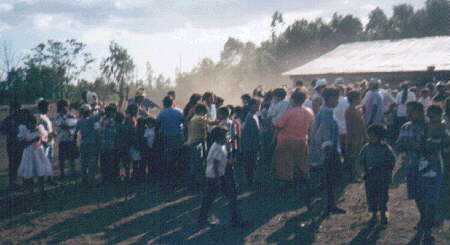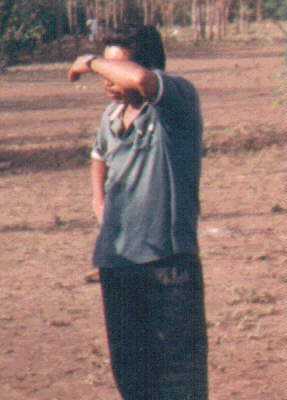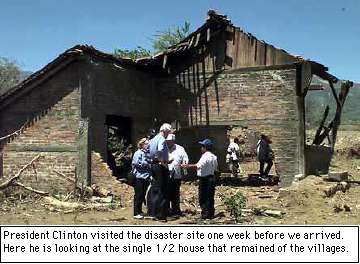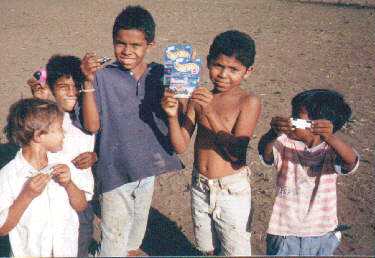


Refugio Betesda
Bethesda Refugee Camp
 In the aftermath of the destruction brought to Central America by Hurricane Mitch, hundreds of families are struggling to ressurect life at RefugioBetesda. The Bethesda Refugee Camp sits on a section of land purchased by relief funds given by Assemblies of God churches in America. The inhabitants are survivors of the Casita Volcano Disaster (this is the term used in international news stories, the volcano is known locally as "Las Casitas").
In the aftermath of the destruction brought to Central America by Hurricane Mitch, hundreds of families are struggling to ressurect life at RefugioBetesda. The Bethesda Refugee Camp sits on a section of land purchased by relief funds given by Assemblies of God churches in America. The inhabitants are survivors of the Casita Volcano Disaster (this is the term used in international news stories, the volcano is known locally as "Las Casitas").In the last days of October 1998, Hurricane Mitch was bringing pounding rains to the small villages that dotted the slopes of the active Casita Volcano in Western Nicaragua. It rained for nine days straight before the mountain collapsed under the weight of the storm, sending a ten foot high wall of geothermally-heated water, mud, and volcanic rock tumbling down on the residents below.
 At the refugee camp the memories are still very painful, but the community struggles to find meaning in the life that remains. Committed individuals from the group have risen to the challenge of leadership, organizing the distribution of relief supplies and setting up a school. One man who lost his entire family summarized the situation well: "I don't know why I'm still alive, but I'm alive because God has a reason. I will keep living to find that reason."
At the refugee camp the memories are still very painful, but the community struggles to find meaning in the life that remains. Committed individuals from the group have risen to the challenge of leadership, organizing the distribution of relief supplies and setting up a school. One man who lost his entire family summarized the situation well: "I don't know why I'm still alive, but I'm alive because God has a reason. I will keep living to find that reason."
Survivors say it sounded like helicopters or airplanes at first, but they realized what was about to be upon them when it became clear the noise was coming from the mountain. An EpiscopalNews Service article picks up the story:The Memories they Live With
 Survivors have lost everything. Only half a house remained where there were a handful of villages. Not only have they lost all their earthly possessions, but most of their families as well. Some are the only survivors of close-knit extended families of sixty or more. Many can tell you stories of loved ones being ripped from their arms by the crush of mud. The man mentioned above tells the chilling tale of his unsuccessful efforts to save his young sons as the waters washed him over a mile from where his house once stood.
Survivors have lost everything. Only half a house remained where there were a handful of villages. Not only have they lost all their earthly possessions, but most of their families as well. Some are the only survivors of close-knit extended families of sixty or more. Many can tell you stories of loved ones being ripped from their arms by the crush of mud. The man mentioned above tells the chilling tale of his unsuccessful efforts to save his young sons as the waters washed him over a mile from where his house once stood.
Our Task force, consisting of 19 men from the HonorBound ministry of the Southern California District Council of the Assemblies of God, visited the refugee camp and the disaster site on March 17, 1999. We were on a week-long trip to visit missions outreaches in Nicaragua (Click here to hear a 152k WAV file of some Nicaraguan school children singing for us.), and we stopped there for a day to deliver food, clothes, tools, and toys. Seeing the need, and being impressed by the determination of the people to rebuild their lives, immediately that evening we went to work planning a way to help them in their endeavor. We have come alongside the leaders in the camp to help provide the resources they need to start over.Their Needs and Our Mission

Now, new homes have been built and CARE has installed a clean water supply, so our project is focussed on their community facilities and land limitations. Our dream is to see a complete school and community gathering facility erected to replace the tents and tarps they set up after the disaster, to help them aquire additional property, and perhaps even to help provide resources for the establishment of crops and or livestock food sources. Latin America ChildCare is helping with a new school with meals & medical care and churches and HonorBound leaders here in Southern California are raising funds for any further purchases of land, the funding of the school's construction and initial two years' operating costs, and to send construction teams to work alongside the camp residents and erect the buildings. As one Nicaraguan pastor puts it: with a little bit of resources, committed people can do a lot in the Lord. (Click here to hear the 99k WAV recorded in Nicaragua.)
We will obviously need a great deal of support to make this dream a reality. Some areas of assistance that may be considered are:How Others Can Help
Prayer: The survivors and their leaders, our team leadership, and the entire project need great amounts of prayer. One-Time Startup Donations: We need to try to raise the $50,000 needed to ensure that the school will have the funds required to remain in operation for the first few years (that includes amounts in the monthly giving below). Monthly School Pledges: A Special Project fund has been established through Latin America ChildCare to provide ongoing funding for student sponsorship and staffing at the school. Work Crews: HonorBound Sectional Representatives will be preparing work teams to go to Nicaragua and assist in the construction of the new community facilities. We will need hard-working volunteers and a handful of expert construction leaders for each team. Work Crew Sponsors: Some of those who will be most available and qualified for these work teams will not have the resources to pay for the costs of travel to the camp. For the most up-to-date information on how to help, see our news page.
![]()
![]() See our scrapbook of photos from our visit on March 17, 1999!
See our scrapbook of photos from our visit on March 17, 1999!
![]() Follow our progress and see up to date info on the project.
Follow our progress and see up to date info on the project.
![]() Read a Newspaper Column one of our guys wrote about his experience.
Read a Newspaper Column one of our guys wrote about his experience.
![]() Read an update from a Missionary in the area.
Read an update from a Missionary in the area.
![]()
![]() Links to other websites about the Casita Disaster:
Links to other websites about the Casita Disaster:
![]() BBCNews Story on this Disaster.
BBCNews Story on this Disaster.
![]() BBCRealPlayer Video Clip of the Nicaraguan Mudslides.
BBCRealPlayer Video Clip of the Nicaraguan Mudslides.
![]() Universityat Buffalo Research: Best site for photos of disaster area.
Universityat Buffalo Research: Best site for photos of disaster area.
![]() USGeological Survey Report on Disaster
USGeological Survey Report on Disaster
![]() Episcopal News Service Report: Personal Survivor Accounts
Episcopal News Service Report: Personal Survivor Accounts
![]() Summaryof Hurricane Mitch's Damage in Central America
Summaryof Hurricane Mitch's Damage in Central America
![]()
Other Pages on this Site:
News, Scrapbook of Photos & Sounds, Team Member Newspaper Article, and a Missionary's Update Letter.